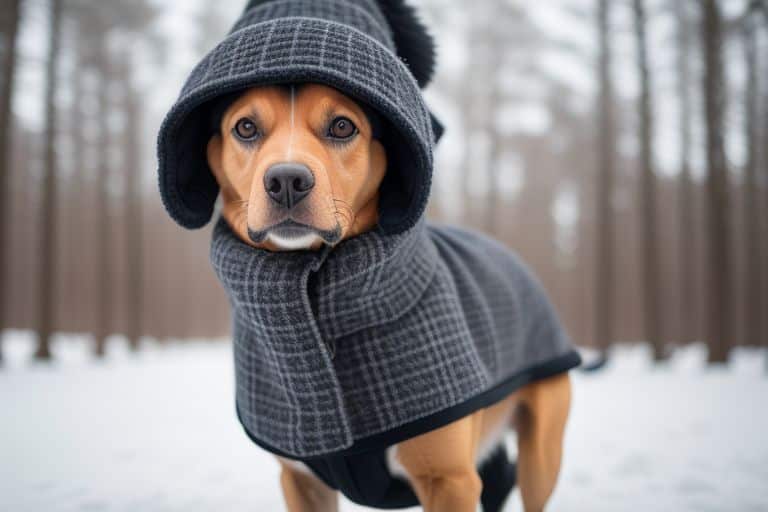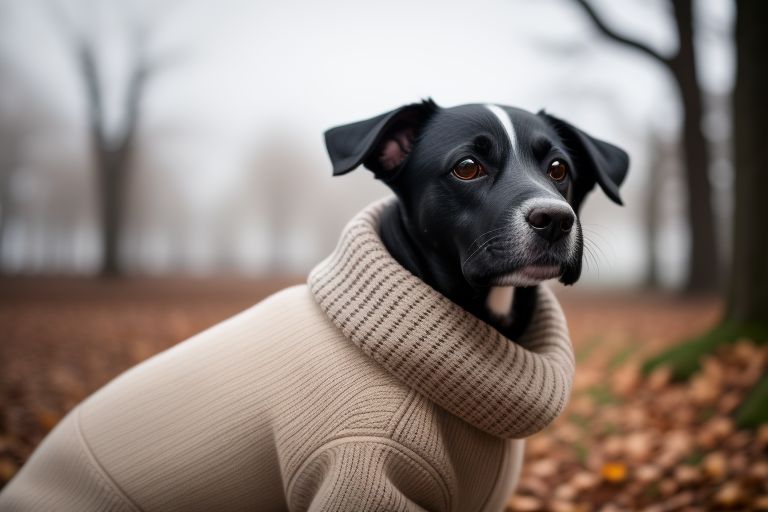Ensuring your dog stays warm in winter is essential. Let’s dispel some common misconceptions and debunk false myths. Contrary to popular belief, a dog’s fur doesn’t always provide adequate protection. While certain breeds may have a higher tolerance for low temperatures due to their physical characteristics and habits, it’s crucial to recognize that cold weather, temperature fluctuations, and drafts can pose challenges for dogs in general.
Table of Contents

How to keep your dog warm in winter
Our pets, including cats, are homeotherms, meaning they can maintain a constant body temperature despite external temperature variations. However, they are sensitive to temperature drops. To ensure the well-being of your dog during winter, it’s advisable to limit their time outdoors.
If your dog usually lives indoors with you, consider adjusting their routines and minimizing outdoor activities. On the other hand, if your dog spends nights outdoors, taking precautions becomes crucial to prevent potential risks.
Here are some helpful tips to effectively navigate the challenges posed by this seasonal transition.
Which dogs handle cold weather the best?
It’s essential to differentiate our canine companions based on age before considering breeding. Puppies and elderly dogs are more susceptible to temperature drops, while young and adult dogs tend to be more resilient. This sensitivity stems from the fact that puppies, especially those under two weeks old, haven’t fully developed their normal body heat and rely on close contact with each other for warmth. Similarly, elderly dogs may experience a general weakening of their physique, as do those who are unwell or prone to health issues.
Size is another critical factor to consider; smaller dogs tend to be more sensitive to cold, while medium to large dogs exhibit greater resistance.
Additionally, take note of the coat type: the presence of an undercoat is indicative of better cold resistance in dogs.

Best Winter Dog Breeds and the Coldest Ones
It’s crucial to distinguish our canine companions based on age before considering breeding. Puppies and elderly dogs are more susceptible to temperature drops, while young and adult dogs tend to be more resilient. This sensitivity arises because puppies, particularly those under two weeks old, haven’t fully developed their normal body heat and rely on close contact with each other for warmth. Likewise, elderly dogs may experience a general weakening of their physique, much like those who are unwell or prone to health issues.
Size is another crucial factor to consider; smaller dogs often exhibit greater sensitivity to the cold, whereas medium to large dogs tend to have more resistance.
Additionally, it’s essential to take note of the coat type: the presence of an undercoat is indicative of better cold resistance in dogs.
Protecting Your Dog in Winter
Regardless of size, age, or fur type, it’s crucial to protect our dogs from low temperatures. Even if they belong to breeds known for their thermal resistance, they are not invulnerable to drafts, sudden temperature changes, frost, and humidity, especially when the mercury falls below 15 degrees. To ensure their well-being, consider the following valuable tips, which are particularly important to implement starting from autumn.

PAY ATTENTION TO THE POWER SUPPLY
Similar to humans, animals tend to burn more calories during winter. Consequently, dietary adjustments are essential, requiring increased protein and fat content. Incorporating larger quantities of both white and red meats, along with fish at least once a week, is recommended. Additionally, providing supplements containing proteins and essential minerals such as copper, zinc, omega-6, and omega-3 can be beneficial for our dogs during the winter months.
KEEP YOUR DOG SHELTERED
The shelter where our dog rests is crucial; maintaining an acceptable temperature, eliminating humidity, and shielding our friend from drafts are key considerations.
Avoid housing your dog in the garage, especially if it’s used for your car or motorbike. This environment is not conducive to their health and poses risks related to leaked fluids from the engine, which the animal could ingest. If using the garage is unavoidable, refrain from starting the engine in the presence of the dog.
For outdoor sleepers, adhering to essential precautions is vital. If temperatures become particularly harsh, consider bringing your dog indoors. Ensure the kennel has a raised floor, proper insulation, and protection from the wind. Additionally, choose a comfortable “bed”; Fido will sleep better on old sweaters or woolen blankets.
CHOOSE AND CHECK THE WATER BOWL
Opting for plastic as the material for your dog’s belongings during winter is ideal due to its low conductivity of heat and cold. Metal and other materials pose risks, such as the potential for a dog’s tongue to stick to the container when drinking. It’s essential to regularly check if the water has frozen.
Regarding coats, they serve a practical purpose rather than just aesthetic appeal. Protective raincoats are especially crucial for small-sized and short-haired dogs. There are various types and shapes available. Accessories like shoes can also be beneficial in safeguarding your friend’s paws and head. Regularly cleaning and drying the paws, along with applying a protective cream in low temperatures, is a helpful practice.

BATHING IN WINTER: HOW OFTEN?
During the winter season, it’s advisable to reduce the frequency of grooming and home bathing. Water tends to wash away the natural protective oils on the skin, increasing the risk of dryness. Instead, focus on frequent brushing to assist in the renewal of the undercoat and opt for dry cleaning methods.
Similarly, consider minimizing the number of walks during winter. If your dog gets wet during a walk in the rain or snow, promptly dry them upon returning home, paying particular attention to the paws and between the toes. This helps maintain their comfort and overall well-being.
HOW TO NOTICE THAT OUR FOUR-LEGGED FRIEND IS COLD?
Despite possessing a higher cold resistance compared to humans, dogs often exhibit noticeable signs of discomfort in chilly conditions. These signals include:
- Trembling
- Slow breathing
- Dry skin
- Muscle stiffness
- Slowed movements
As temperatures drop, and if the recommended guidelines are not adhered to, dogs become more vulnerable to various diseases and disorders. For instance, older dogs are prone to arthritis, while infectious tracheobronchitis, commonly known as kennel cough, becomes a heightened risk. Recognizing these signs and taking appropriate measures is crucial for maintaining the well-being of our canine companions during colder seasons.
THE DOG IN WINTER: LAST TIPS AND PREVENTION
Prevention stands as the most effective weapon against the risk of various health problems. In addition to offering continuous care and following essential precautions against the cold, it’s crucial to adhere to the schedule of periodic veterinary checks and ensure that primary vaccinations are up-to-date.
For those concerned about the potential costs but unwilling to compromise on their friend’s well-being, a dog insurance plan can be a valuable resource. A comprehensive policy not only guarantees continuous telephone assistance but also provides discounted rates and free visits in case of accidents or illnesses.
While insurance may not shield your dog from the cold, the coverage it offers can prove invaluable in safeguarding their overall health and ensuring prompt and effective veterinary care.
Also Read: How to teach your dog not to bark